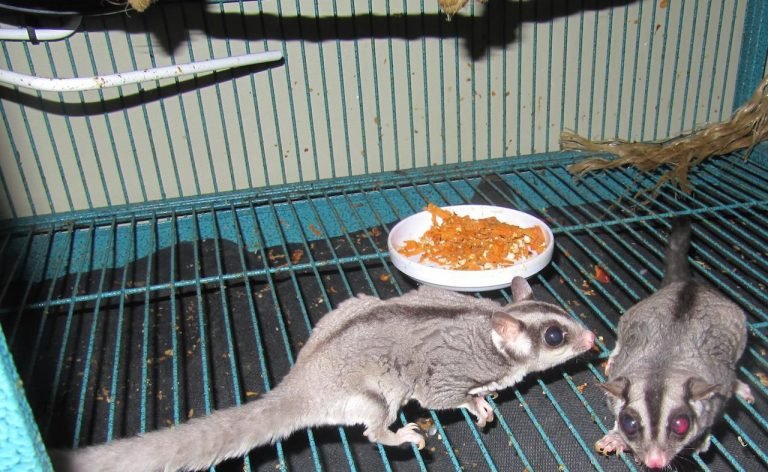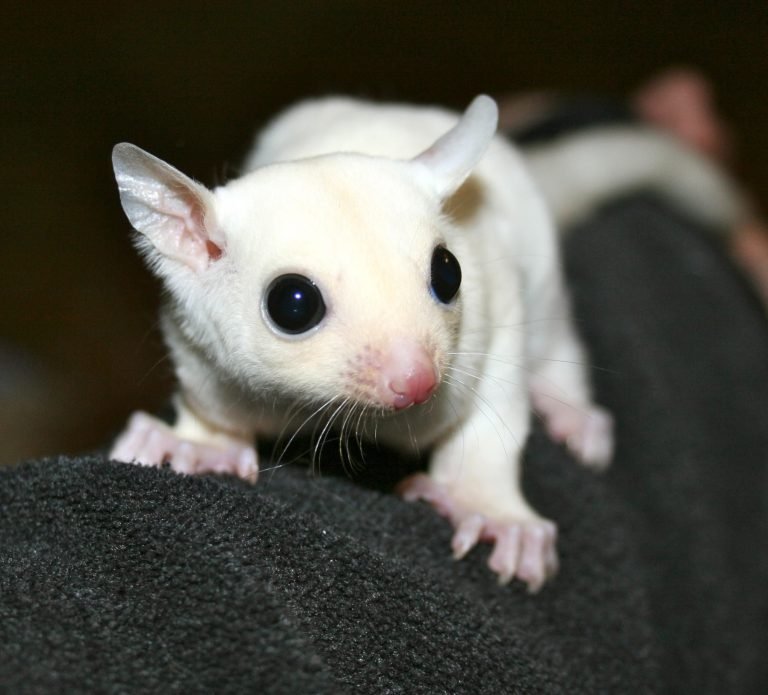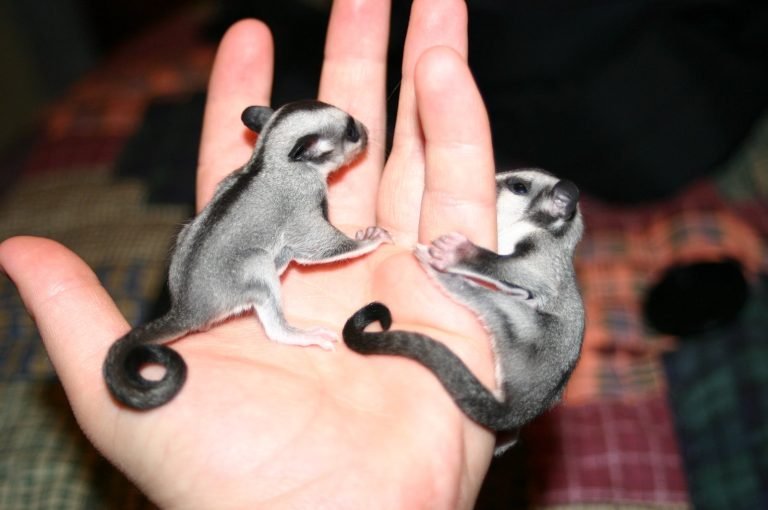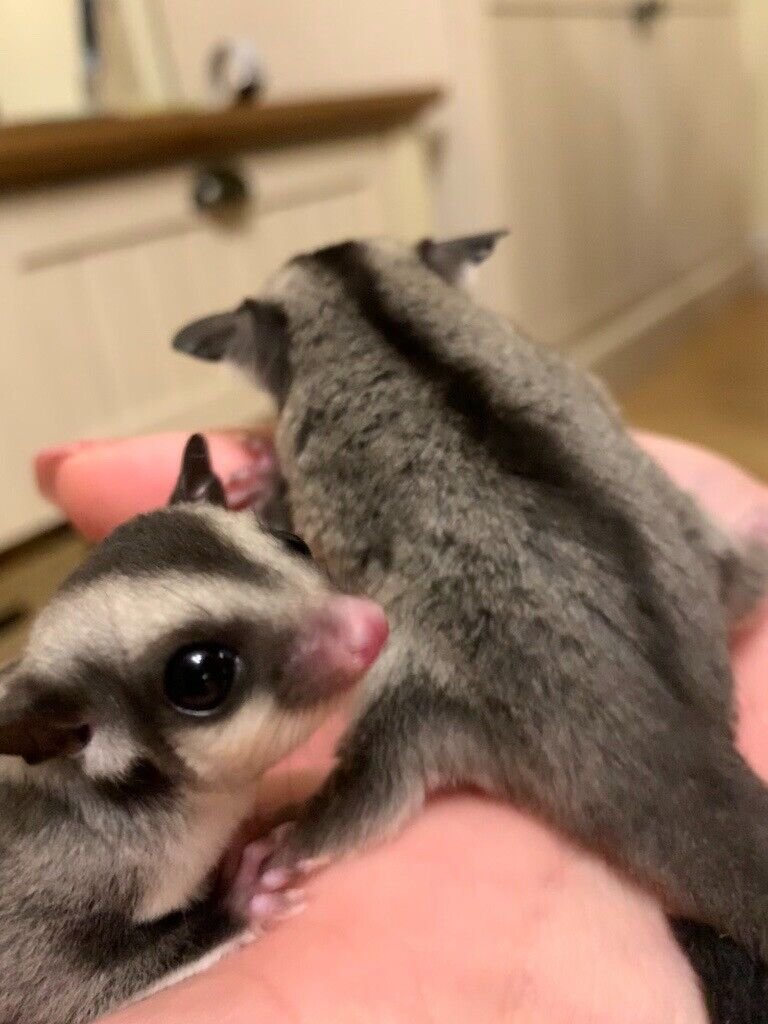What Is a White Sugar Glider? 9 Fascinating Facts!
Curious about the enigmatic white sugar glider? Unravel the mystery with “What Is a White Sugar Glider? 9 Fascinating Facts!” This captivating article unveils intriguing insights into these unique creatures. Explore the genetic origins of white sugar gliders, their rare occurrence in the wild, and how they differ from their colorful counterparts. Discover nine fascinating facts about their appearance, behavior, and habitat, shedding light on their captivating nature. From their endearing personality traits to the significance of their white coat, we’ve got you covered.
Whether you’re a seasoned sugar glider enthusiast or a curious newcomer, this article will deepen your appreciation for these extraordinary marsupials. Delve into the world of white sugar gliders and unlock the secrets of their mesmerizing charm today!
Colors and Variations of Sugar Gliders
Different Color Variations of Sugar Gliders
Sugar gliders are fascinating gliding species that come in a variety of colors, each with its unique beauty. The most common color variation is the classic gray sugar glider, which has a light silver body color and gray markings on its dorsal stripe. However, there are several other color variations that you might come across, including those with striking red eyes.
One such variation is the albino sugar glider, which has a white body color and pink eyes due to a lack of melanin. Another rare variation is the platinum sugar glider, which has a lighter silver body color than the classic gray sugar glider. There’s also the creamino sugar glider, which has a creamy white body color with caramel-colored ears and nose. Leucitic gliders, which have a partial loss of pigmentation resulting in a pale coloration, are also known to exist. Mosaic gliders, on the other hand, have distinct patches of different colors on their fur. These unique variations are well adapted for gliding through the air using their skin flaps. Some sugar gliders also have a distinctive black face that sets them apart from others.
Apart from these more popular variations, there are mosaic gliders that have different color patterns on their bodies, making them a unique species of gliding mammals. These mosaics are known for their impressive gliding abilities, often soaring through the air with ease. Some even have a distinct dorsal stripe running down their backs, adding to their already striking appearance.
How Genetics Play A Role in Determining Their Colors
The genetics of sugar gliders play an essential role in determining their colors and dorsal stripe pattern. As a species known for gliding, the coloration of their fur can serve as camouflage against predators. Each parent passes down specific genes to their offspring that determine the baby’s coat color and pattern. For instance, if both parents carry a red gene, then there’s a high chance that their offspring will be born with a reddish tint in their fur.
Certain genes can cause variations like mosaic or caramel coloring when combined with other genes in sugar gliders, a species of gliding marsupials known for their black face. It’s crucial to understand these genetic factors before breeding them so that you can predict what kind of offspring they’ll produce, including those with dark fur variations.
Rarity and Popularity of Certain Color Variations
While some colors like classic gray or light silver are quite common among sugar glider species, others like albino or platinum variations are rarer and more sought after by collectors due to a unique gene. Dark or red sugar gliders are also highly sought after and can be more expensive than regular sugar gliders due to their rarity.
For example, albino sugar gliders are among the rarest and most expensive color variations. They’re highly prized by collectors due to their unique white color and pink eyes. Similarly, platinum sugar gliders are also quite rare and sought after because of their lighter silver body color. However, some species of sugar gliders have a dark gray fur while others have a reddish tint, making them distinct from their counterparts.
On the other hand, dark caramel or black beauty sugar gliders are relatively more common species but still have a unique appearance that sets them apart from classic gray sugar gliders. They may even have a red tinge to their fur or a distinctive white face.
Characteristics and Behavior of White Sugar Gliders

Physical traits that distinguish white sugar gliders from other colors
White sugar gliders are a rare color variation of the common sugar glider species, Petaurus breviceps. The most notable physical trait that distinguishes them from other colors is their white fur, which is caused by a recessive gene. Gray and red color variations are also possible but less common.
In addition to their striking white fur, the sugar glider species may also have a black face, which is caused by a gene that produces a dark pigment. White sugar gliders with this gene can have dark paw pads and noses, further setting them apart from other color variations. However, it’s important to note that not all white sugar gliders carry this gene and may not exhibit these features.
Behavioral differences between white sugar gliders and other colors
While there is no evidence to suggest that the behavior of white sugar gliders species differs significantly from other color variations, some owners have reported subtle differences in temperament. For example, some claim that their white sugar glider offspring are more docile and less likely to bite or nip than their non-white counterparts. It is believed that this may be due to a specific gene that produces the white fur, which could also affect the dark pigmentation in the eyes.
However, it’s worth noting that individual personality plays a significant role in a sugar glider’s behavior regardless of its coloration. Proper socialization and handling can greatly influence a sugar glider’s temperament regardless of its genetics. This applies to both albino gliders and leucistic gliders, which are variations of the species. It is also important to consider the genetics of potential offspring when breeding sugar gliders with specific colorations.
How white sugar glider’s behavior changes with age
Like all offspring of the white sugar glider species, joeys go through several developmental stages as they grow up. During this time, their gene-based behavior will change as they become more independent and develop new skills.
For white sugar gliders, which are a species of marsupials, specifically, there are no known behavioral changes associated with their unique coloring as they age. However, it’s important to note that all baby sugar gliders, or offspring, require plenty of attention and care during the first few months of life in order to develop into healthy adults. Additionally, the black face coloration in sugar gliders is determined by a gene.
As a species, the behavior of white sugar gliders will largely depend on their individual personalities and how they were raised. Some offspring may inherit certain genes that make them more outgoing and social, while others may inherit genes that make them more reserved and prefer to spend time alone. Additionally, the face of each glider can also give clues to their personality, as some may have more expressive or friendly-looking faces than others.
The Fascinating Facts about White Sugar Gliders
Why Some People Prefer White Sugar Gliders Over Other Colors
Sugar gliders are a species of small, nocturnal marsupials that are native to Australia, New Guinea, and Indonesia. They are known for their gliding ability, which allows them to travel from tree to tree in search of food and shelter. While sugar gliders come in a variety of colors, some people prefer the black sugar glider over other colors because of their unique appearance. Their face is also a distinguishing feature, with a pointed snout and large eyes. Additionally, some sugar gliders have a mosaic pattern on their fur, creating a beautiful and intricate design.
White and black sugar gliders are a species of small marsupials known for their distinctive white or black fur. Some individuals may exhibit a mosaic pattern, with patches of both white and black fur. In addition to the white and black color variations, there is also a rare cremino mutation that results in a cream-colored coat. These colorations are caused by genetic mutations that affect the production of melanin, the pigment responsible for skin and hair color in animals. While white and black sugar gliders are not albino (which would result in pink eyes), they do lack pigmentation in their skin and eyes.
Interesting Facts About the Genetic Mutation That Causes Whiteness in Sugar Gliders

The genetic mutation that causes whiteness in sugar gliders is rare but occurs naturally in wild populations. However, black sugar gliders with white faces and cremino sugar gliders are also found in captive breeding programs where breeders selectively breed for these traits. It’s important to note that breeding for specific traits can lead to health problems if not done responsibly.
In addition to affecting fur coloration, this genetic mutation also affects the structure of the animal’s hair follicles. Black sugar glider hairs are thicker than those of wild type sugar gliders and may be more resilient to breaking or falling out. The mutation can also impact the face of the sugar glider, causing a distinctive cremino pattern.
The Impact of Captivity on the Prevalence of White Sugar Glider Populations
The prevalence of white sugar glider populations has increased due to selective breeding practices within captivity. However, it’s important to remember that these animals were originally wild animals and require specialized care if kept as pets. Leucistic gliders, with their unique white face and bright eyes, are a popular variation of the species. The cremino coloration is also highly sought after by glider enthusiasts.
Sugar gliders need a large habitat with plenty of vertical space for climbing and jumping. They also require a diet that includes protein, fruits, and vegetables to keep their face healthy. Toys and other environmental enrichment items are necessary to keep them mentally stimulated.
It’s important to note that sugar gliders, including cremino and white face varieties, are social animals and should be kept in pairs or small groups. If kept alone, they can become depressed and develop health problems.
Complete Guide to Leucistic Sugar Gliders
Understanding Leucism in Animals
Leucism is a genetic condition that affects the pigmentation of animals, including their fur, skin, and eyes. Unlike albinism, where animals lack melanin, leucistic animals have some pigment cells but are unable to produce melanin. In sugar gliders, leucistic variants are known as white sugar gliders and can have a pale face. Additionally, there is a rare type of leucistic sugar glider called the cremino sugar glider, which has a creamy coloration.
Differences between Albinism and Leucism
While both conditions result in a lack of pigmentation, there are no significant differences between albinism and leucism when it comes to the face. Albinos have no melanin production at all, resulting in completely white hair, pink eyes, and translucent skin on the face. They also have vision problems due to the absence of pigment in their retinas. The cremino gene has been linked to leucism in certain animals but not in humans.
On the other hand, leucistic animals retain some pigment cells but cannot produce melanin effectively. Therefore they may have faint coloration on their skin or fur and colored eyes instead of pink ones like albinos. This is particularly noticeable in white-faced sugar gliders, which are often referred to as cremino sugar gliders. If you’re interested in sugar glider products, it’s worth noting that white sugar gliders fall under the category of leucistic animals.
Identifying a White Sugar Glider
White sugar gliders are easily identified by their pale or white-colored fur and skin. However, not all white sugar gliders are leucistic; some may be albino or carry other color mutations like platinum or mosaic genes. When looking closely at their face, the white fur can be particularly noticeable.
To identify if a sugar glider is truly leucistic:
- Look for patches of faint coloration on their skin
- Check if they have black eyes (leucistics and white sugar gliders can still produce other pigments) and a white face.
- Observe if they display any traits associated with other mutations like platinum’s silver-tipped ears or mosaics’ patchy coat patterns. Also, look out for characteristics of a white sugar glider such as its white face.
Caring for White Sugar Gliders
Like regular sugar gliders, white sugar gliders require specialized care to thrive as pets. Here are some tips for taking care of your pet’s face:
- Provide your white sugar glider with a spacious cage with plenty of room to climb and glide, especially if they have a white face.
- Feed your white sugar glider and white face a balanced diet of fresh fruits, vegetables, and protein sources like mealworms or crickets.
- Give them plenty of socialization time outside their cage to bond with you and other gliders, face to face.
- Regularly groom their fur, including their face, to prevent matting or skin irritations, especially for white sugar gliders.
It’s also important to note that white sugar gliders may have some health issues associated with leucism, such as vision problems or susceptibility to sunburn, especially on their face. Therefore it’s crucial to take extra care when handling them and provide appropriate environmental conditions.
Caring for Leucistic Sugar Gliders as Pets
Leucistic sugar gliders are a rare and unique breed of sugar gliders that have a genetic mutation resulting in their white or cream-colored fur. These pets require specific care and attention to ensure they remain healthy and happy.
Specific Care Requirements for Leucistic Sugar Glider Pets
There are several things you need to keep in mind, including the care and keeping of your white sugar glider.
- Diet: Leucistic sugar gliders require a balanced diet of fruits, vegetables, proteins, and fats. It is crucial to avoid feeding them sugary foods like candy or processed treats.
- Housing: Your pet leucistic sugar glider needs a spacious cage with plenty of room to move around and play. The cage should include toys, climbing structures, and nesting boxes.
- Exercise: Sugar gliders are active animals that need plenty of exercise every day. Provide them with opportunities to run, climb, glide, and play outside their cage.
- Socialization: Leucistic sugar gliders are social animals that thrive on interaction with their owners. They need daily handling and playtime to bond with you.
Health Concerns Unique to Leucistic Sugar Glider Pets
Leucism is a genetic condition that affects pigmentation in animals’ skin cells causing partial or complete loss of coloration; however, it does not affect the animal’s overall health or lifespan significantly. Nevertheless, there are some health concerns unique to leucistic sugar glider pets that you need to be aware of:
- Sunburn: Leucistic sugar gliders have sensitive skin due to the lack of melanin in their fur. Therefore, they are prone to sunburn and should not be exposed to direct sunlight for prolonged periods.
- Eye problems: Leucistic sugar gliders have a higher risk of developing eye problems such as cataracts or glaucoma.
- Allergies: Some leucistic sugar gliders may develop allergies to certain foods, bedding materials, or cleaning products.
Tips for Bonding with Your Pet Leucistic Sugar Glider
Bonding with your pet leucistic sugar glider is essential for building a strong relationship and ensuring its happiness. Here are some tips on how to bond with your pet:
- Spend time together: Take your white sugar glider out of the cage every day and spend time playing with it, holding it, or letting it sit on your shoulder.
- Offer treats: Use treats like fresh fruit or mealworms as positive reinforcement during training sessions for your white sugar glider.
- Be patient: Leucistic sugar gliders can take time to warm up to new people and environments; therefore, patience is crucial when bonding with them.
Cost of White Sugar Gliders
Factors Affecting the Cost of Purchasing a White or Leucistic Sugar Glider
If you’re considering getting a white sugar glider, one of the first things you’ll want to know is how much it will cost. The price of a white or leucistic sugar glider can vary depending on several factors. One significant factor that affects the cost is the rarity of these color variations compared to more common gray and brown sugar gliders.
Another factor that influences the cost is where you buy your pet from. If you purchase from a breeder, prices may be higher due to their expertise in breeding and raising healthy sugar gliders. However, buying from a pet store might be cheaper but less reliable regarding the quality of care provided by breeders.
Average Prices for Acquiring a Pet White or Leucistic Sugar Glider
The average price for purchasing a white or leucistic sugar glider ranges between $250-$500, depending on various factors such as age, gender, lineage, and location. Older sugar gliders or those with specific genetic traits may cost more than younger ones without any unique features.
Moreover, additional fees may apply when purchasing your new pet. These costs include veterinary visits for checkups and vaccinations if they haven’t already been administered at the time of purchase. You should also consider buying an appropriate cage with toys and accessories to keep your pet happy and healthy, especially if you are planning to get a white sugar glider.
Additional Costs Associated with Owning a Pet Sugar Glider
Owning a pet sugar glider requires ongoing expenses beyond initial costs like purchasing them and setting up their habitat. Some recurring costs associated with owning this type of animal include food, bedding material replacement, cleaning supplies for their cage maintenance routine (such as disinfectants), grooming tools like nail clippers or brushes if needed.
In addition to these expenses mentioned above, there are also potential medical bills that may come up if your sugar glider becomes ill or injured. It’s essential to have a veterinarian who is knowledgeable about these animals and can provide proper care in case of any health issues.
Understanding White Sugar Gliders
In conclusion, white sugar gliders are a unique and fascinating variation of the popular pet. As we have learned, these gliders have a beautiful white fur coat and share many characteristics and behaviors with their traditional counterparts.
It’s important to note that caring for a white sugar glider requires specific knowledge and attention. From providing a proper diet to creating an appropriate living space, owners must be prepared for the responsibilities that come with owning this type of pet.
If you’re interested in bringing a white sugar glider into your home, make sure to do thorough research and seek advice from experienced owners or reputable breeders.
FAQs
1. Are white sugar gliders more expensive than traditional ones?
Yes, due to their rarity, white sugar gliders can be more expensive than traditional ones. Expect to pay anywhere from $500-$2000 depending on the breeder and location.
2. Can I keep a single white sugar glider as a pet?
It is not recommended to keep a single sugar glider as they are social animals that thrive in pairs or groups. Consider adopting two or more if you’re interested in owning these pets.
3. Do white sugar gliders require any special care compared to traditional ones?
While they share many similarities with traditional sugar gliders, it’s important to note that leucistic (white) individuals may have weaker immune systems and require extra care.
4. Can I train my white sugar glider like other pets?
Yes! Sugar gliders can be trained using positive reinforcement techniques such as clicker training. However, it’s important to remember that they are still wild animals at heart and may not behave exactly like domesticated pets.
5. What should I feed my white sugar glider?
A balanced diet for your pet should consist of a variety of fresh fruits, vegetables, and protein sources such as insects or cooked chicken. Consult with your veterinarian or an experienced sugar glider owner for specific dietary recommendations.
6. Are white sugar gliders legal to own as pets?
In most places, yes! However, it’s important to check with your local laws and regulations regarding exotic pet ownership before bringing a white sugar glider into your home.







